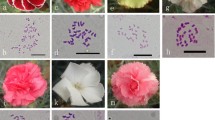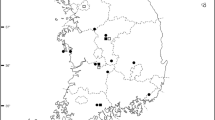Abstract
Experimental crosses between diploids, triploids and tetraploids ofHieracium echioides were made to examine mating interactions. Specifically, cytotype diversity in progeny from experimental crosses, intercytotype pollen competition as a reproductive barrier between diploids and tetraploids, and differences in seed set between intra- and intercytotype crosses were studied. Only diploids were found in progeny from 2x × 2x crosses. The other types of crosses yielded more than one cytotype in progeny, but one cytotype predominated in each cross type: diploids (92%) in 2x × 3x crosses, tetraploids (88%) in 3x × 2x crosses, triploids (96%) in 2x × 4x crosses, triploids (90%) in 4x × 2x crosses, tetraploids (60%) in 3x × 3x crosses, pentaploids (56%) in 3x × 4x crosses, triploids (80%) in 4x × 3x crosses and tetraploids (88%) in 4x × 4x crosses. No aneuploids have been detected among karyologically analyzed plants. Unreduced egg cell production was detected in triploids and tetraploids, but formation of unreduced pollen was recorded only in two cases in triploids. Triploid plants produced x, 2x and 3x gametes: in male gametes x (92%) gametes predominated whereas in female gametes 3x (88%) gametes predominated.
Cytotype diversity in progeny from crosses where diploids and tetraploids were pollinated by mixture of pollen from diploid and tetraploid plants suggested intercytotype pollen competition to serve as a prezygotic reproductive barrier. No statistically significant difference in seed set obtained from intra- and intercytotype crosses between diploids and tetraploids was observed, suggesting the absence of postzygotic reproductive barriers among cytotypes.
Similar content being viewed by others
References
Averett J.E. (1980): Polyploidy in plant taxa: summary. In:Lewis W.H. (ed.),Polyploidy, biological relevance, Plenum Press, New York, pp. 269–273.
Bräutigam S. (1992):Hieracium L. In:Meusel H. &JäGER E.J. (eds.),Vergleichende Chorologie der zentraleuropäischen Flora 3, Gustav Fischer, Jena, Stuttgart et New York, pp. 325–333, 550–560.
Bräutigam S. &Bräutigam E. (1996): Determination of the ploidy level in the genusHieracium subgenusPilosella (HILL)S.F. Gray by flow cytometric DNA analysis.Folia Geobot. Phytotax. 31: 315–321.
Bretagnolle F. &Thompson J.D. (1995): Tansley review no. 78. Gametes with the somatic chromosome number: mechanisms of their formation and role in the evolution of autopolyploid plants.New Phytol. 129: 1–22.
Bretagnolle F. &Thompson J.D. (1996): An experimental study of ecological differences in winter growth between sympatric diploid and autotetraploidDactylis glomerata.J. Ecol. 84: 343–351.
Burton T.L. &Husband B.C. (2000): Fitness differences among diploids, tetraploids, and their triploid progeny inChamerion angustifolium: Mechanisms of inviability and implications for polyploid evolution.Evolution 54: 1182–1191.
Burton T.L. &Husband B.C. (2001): Fecundity and offspring ploidy in matings among diploid, triploid and tetraploidChamerion angustifolium (Onagraceae): consequences for tetraploid establishment.Heredity 87: 573–582.
De Wet J.M.J. (1980): Origins of polyploids. In:Lewis W.H. (ed.),Polyploidy, biological relevance, Plenum, New York, pp. 3–16.
Dyer A.F. (1963): The use of lacto-propionic orcein in rapid squash methods for chromosome preparations.Stain Technol. 38: 85–90.
Felber F. (1991): Establishment of a tetraploid cytotype in a diploid population: effect of relative fitness of the cytotypes.J. Evol. Biol. 4: 195–207.
Fowler N.L. &Levin D.A. (1984): Ecological constraints on the establishment of a novel polyploid in competition with its diploid progenitor.Amer. Naturalist 124: 703–711.
Gadella T.W.J. (1987): Sexual tetraploid and apomictic pentaploid populations ofHieracium pilosella (Compositae).Pl. Syst. Evol. 157: 219–245.
Gadella T.W.J. (1988): Some notes on the origin of polyploidy inHieracium pilosella aggr.Acta Bot. Neerl. 37: 515–522.
Gadella T.W.J. (1991): Variation, hybridization and reproductive biology ofHieracium pilosella L.Proc. Kon. Ned. Akad. Wetensch., Ser.C., Biol. Med. Sci. 94: 455–488.
Hardy O.J., Loose M., Vekemans X. &Meerts P. (2001): Allozyme segregation and inter-cytotype reproductive barriers in the polyploid complexCentaurea jacea.Heredity 87: 136–145.
Hardy O.J., Vanderhoeven S., de Loose M. &Meerts P. (2000): Ecological, morphological and allozymic differentiation between diploid and tetraploid knapweeds (Centaurea jacea) from a contact zone in the Belgian Ardennes.New Phytol. 146: 281–290.
Harlan J.R. &De Wet J.M.J. (1975): On Ö. Winge and a prayer: the origins of polyploidy.Bot. Rev. 41: 361–390.
Husband B.C. (2000): Constraints on polyploid evolution: a test of the minority cytotype exclusion principle.Proc. Roy. Soc. London, Ser. B, Biol. Sci. 267: 217–223.
Husband B.C. (2004): The role of triploid hybrids in the evolutionary dynamics of mixed-ploidy populations.Biol. J. Linn. Soc. 82: 537–546.
Husband B.C. &Schemske D.W. (1998): Cytotype distribution at a diploid-tetraploid contact zone inChamerion (Epilobium) angustifolium (Onagraceae).Amer. J. Bot. 85: 1688–1694.
Husband B.C., Schemske D.W., Burton T.L. &Goodwillie C. (2002): Pollen competition as a unilateral reproductive barrier between sympatric diploid and tetraploidChamerion angustifolium.Proc. Roy. Soc. London, Ser. B, Biol. Sci. 269: 2565–2571.
Jay M., Reynaud J., Blaise S. &Cartier D. (1991): Evolution and differentiation ofLotus corniculatus/Lotus alpinus populations from French south-western Aps. III. Conclusions.Evol. Trends Pl. 5: 157–160.
Kashin A.S. &Chernishova M.P. (1997): Chastota apomiksisa v populyatsiyakh nekotorykh vidovTaraxacum iHieracium (Asteraceae) (The frequency of apomixis in populations of someTaraxacum andHieracium species (Asteraceae).Bot. Zhurn. 82: 14–24.
Krahulcová A. &Krahulec F. (2000): Offspring diversity inHieracium subgen.Pilosella (Asteraceae): new cytotypes from hybridization experiments and from open pollination.Fragm. Florist. Geobot. 45: 239–255.
Krahulcov’a A., Chrtek J. &Krahulec F. (1999): Autogamy inHieracium subgen.Pilosella. Folia Geobot. 34: 377–390.
Krahulcová A., Krahulec F. &Chapman H.M. (2000): Variation inHieracium subgen.Pilosella (Asteraceae): what do we know about its sources?Folia Geobot. 35: 319–338.
Krahulcová A., Papoušková S. &Krahulec F. (2004): Reproduction mode in the allopolyploid facultatively apomictic hawkweedHieracium rubrum (Asteraceae, H. subgen.Pilosella).Hereditas 141: 19–30.
Levin D.A. (1975): Minority cytotype exclusion in local plant populations.Taxon 24: 35–43.
Lumaret R. &Barrientos E. (1990): Phylogenetic relationships and gene flow between sympatric diploid and tetraploid plants ofDactylis glomerata (Gramineae).Pl. Syst. Evol. 169: 81–96.
Lysák M.A. &Dolezel J. (1998): Estimation of nuclear DNA content inSesleria (Poaceae).Caryologia 51: 123–132.
Májovský et al. (1970): Index of chromosome numbers of Slovakian Flóra. Part 2.Acta Fac. Rerum Nat. Univ. Comenianae, Bot. 18: 45–60.
Májovský J., Uhríková A., Javorčíková D., Mičieta K., Králik E., Dúbravcová Z., Feráková V., Murín A., Černušáková D., Hindáková M., Schwarzová T. &Záborský J. (2000): Prvý doplnok karyotaxonomického prehl’adu flóry Slovenska (First supplement to the karyotaxonomical survey of the flora of Slovakia).Acta Fac. Rerum Nat. Univ. Comenianae, Bot. Suppl. 1: 1–127.
Marks G.E. (1966): The origin and significance of intraspecific polyploidy: experimental evidence fromSolanum chacoense.Evolution 20: 552–557.
Masterson J. (1994): Stomatal size in fossil plants: evidence for polyploidy in majority of angiosperms.Science 264: 421–24.
Otto F. (1990): DAPi staining of fixed cells for high-resolution flow cytometry of nuclear DNA. In:Crissman H.A. &Darzynkiewicz Z. (eds.),Methods in cell biology 33, Academic Press, New York, pp. 105–110.
Peckert T. (2001): Hieracium echioidesa H. rothianumve střední Evropě (Hieracium echioidesand H. rothianumin Central Europe). Diploma thesis, Department of Botany, Faculty of Science, Charles University, Prague.
Peckert T., Chrtek J. jun. &Plačková I. (2005): Genetic variation in agamospermous populations ofHieracium echioides (Compositae) in southern Slovakia and northern Hungary (Danube Basin).Preslia 77: 307–315.
Petit C., Bretagnolle F. &Felber F. (1999): Evolutionary consequences of diploid-polyploid hybrid zones in wild species.Trends Ecol. Evol. 14: 306–311.
Ramsey J. &Schemske D.W. (1998): Pathways, mechanisms, and rates of polyploid formation in flowering plants.Annual Rev. Ecol. Syst. 29: 467–501.
Richards A.J. (1997):Plant breeding systems. Ed. 2. Chapman & Hall, London.
Rodríguez D.J. (1996): A model for the establishment of polyploidy in plants.Amer. Naturalist 147: 33–46.
Rotreklová O., Krahulcová A., Mráz P., Mrázová V., MáRTONFIOVá L., Peckert T. &Šingliarová B. (2005): Chromosome numbers and breeding systems in some species ofHieracium subgen.Pilosella from Europe.Preslia 77: 177–195.
Rotreklová O., Krahulcová A., Vaňková D., Peckert T. &Mráz P. (2002): Chromosome numbers and breeding systems in some species ofHieracium subgen.Pilosella from Central Europe.Preslia 74: 27–44.
Segraves K.A., Thompson J.N., Soltis P.S. &Soltis D.E. (1999): Multiple origins of polyploidy and the geographic structure ofHeuchera grossulariifolia.Molec. Ecol. 8: 253–262.
Schuhwerk F. &Lippert W. (1997): Chromosomenzahlen vonHieracium (Compositae, Lactuceae) Teil 1.Sendtnera 4: 181–206.
Skalińska M. (1971): Experimental and embryological studies inHieracium aurantiacum L.Acta Biol. Cracov., Ser. Bot. 14: 139–159.
Skalińska M. (1973): Further studies in facultative apomixis ofHieracium aurantiacum L.Acta Biol. Cracov., Ser. Bot. 16: 121–133.
Skalińska M. (1976): Cytological diversity in the progeny of octoploid facultative apomicts ofHieracium aurantiacum L.Acta Biol. Cracov., Ser. Bot. 19: 39–46.
Soltis D.E. (1984): Autopolyploidy inTolmiea menziesii (Saxifragaceae).Amer. J. Bot. 71: 1171–1174.
Stebbins G.L. (1950):Variation and evolution in plants. Columbia University Press, New York.
Thompson J.D. &Lumaret R. (1992): The evolutionary dynamics of polyploid plants: origins, establishment and persistence.Trends Ecol. Evol. 7: 302–307.
Van Dijk P. &Bakx-Schotman T. (1997): Chloroplast DNA phylogeography and cytotype geography in autopolyploidPlantago media.Molec. Ecol. 6: 345–352.
Yahara T. (1990): Evolution of agamospermous races inBoehmeria andEupatorium.Pl. Spec. Biol. 5: 183–196.
Author information
Authors and Affiliations
Corresponding author
Rights and permissions
About this article
Cite this article
Peckert, T., Chrtek, J. Mating interactions between coexisting dipoloid, triploid and tetraploid cytotypes ofHieracium Echioides (Asteraceae). Folia Geobot 41, 323–334 (2006). https://doi.org/10.1007/BF02904945
Received:
Revised:
Accepted:
Issue Date:
DOI: https://doi.org/10.1007/BF02904945




